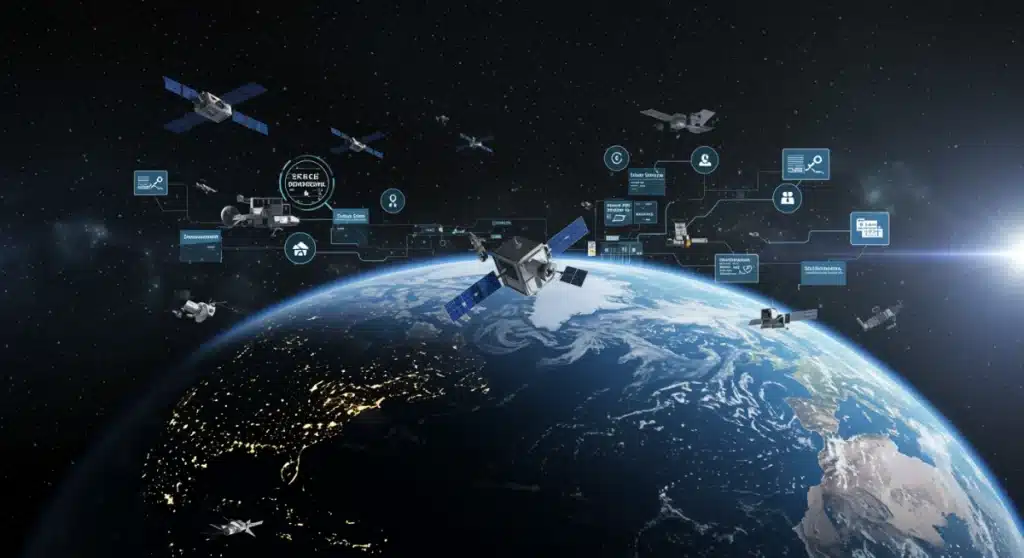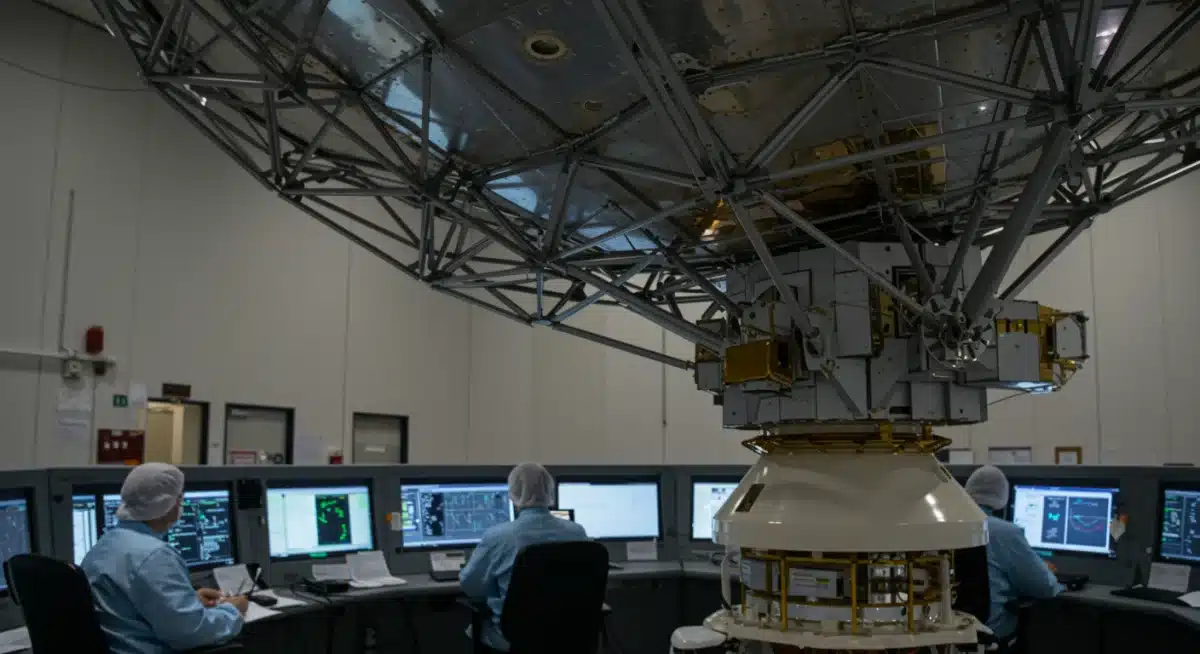US Space Governance: New Regulations Expected by Mid-2025

The United States is poised to introduce significant new regulations concerning space governance by mid-2025, aiming to address the rapidly evolving commercial and national security challenges in orbit.
The burgeoning space economy and the increasing strategic importance of orbital assets are pushing the United States towards a critical juncture in its approach to space regulation. By mid-2025, significant new regulations are expected to reshape US space governance, impacting everything from satellite launches to orbital debris mitigation and national security considerations. This seismic shift aims to provide clarity, foster innovation, and safeguard American interests in the final frontier.
The Evolving Landscape of Space Activities
Space is no longer solely the domain of government agencies. The past decade has witnessed an explosion in private sector involvement, from commercial launch providers to satellite constellations offering global internet access. This rapid expansion brings unprecedented opportunities but also complex challenges for regulators.
The sheer volume of objects in orbit, coupled with the increasing capabilities of space actors, necessitates a more robust and adaptable governance framework. Current regulations, often rooted in decades-old treaties and domestic laws, struggle to adequately address the pace of technological advancement and the diversification of space activities.
Commercialization and its Regulatory Gaps
The commercial space sector is innovating at an incredible speed, leading to new services and technologies that existing regulations did not anticipate. This includes everything from on-orbit servicing and manufacturing to active debris removal and space tourism. Without clear rules, these nascent industries face uncertainty, potentially hindering investment and growth.
- Satellite Constellations: The deployment of thousands of new satellites by companies like SpaceX and Amazon raises concerns about orbital congestion and radio frequency interference.
- In-orbit Servicing: Missions to refuel, repair, or upgrade satellites create new legal questions regarding liability, property rights, and the potential for dual-use technologies.
- Space Tourism: As private citizens venture into space, a clear regulatory framework for safety, insurance, and responsibility becomes paramount.
The need for updated regulations is not merely about control; it’s about enabling sustainable growth and ensuring fair competition. A well-defined legal environment can provide the predictability necessary for businesses to thrive and for the U.S. to maintain its leadership in the global space economy.
In essence, the evolving landscape demands a proactive regulatory approach that can keep pace with innovation while addressing the inherent risks associated with increased space activity. The upcoming regulations are expected to provide much-needed clarity and structure for these emerging sectors.
National Security Imperatives in Orbit
Beyond commercial interests, the national security dimension of space has intensified dramatically. Space systems are integral to modern military operations, intelligence gathering, and critical infrastructure. Protecting these assets and ensuring their uninterrupted function is a top priority for the U.S. government.
Adversaries are developing capabilities that could threaten U.S. space assets, ranging from anti-satellite weapons to sophisticated cyberattacks on ground infrastructure. This evolving threat landscape mandates a comprehensive and adaptive regulatory and policy response.
Addressing New Threats and Capabilities
The traditional understanding of space as a sanctuary is rapidly eroding. The weaponization of space, whether through kinetic or non-kinetic means, presents significant challenges to stability and security. New regulations must account for these dynamics, fostering responsible behavior while deterring aggression.
- Anti-Satellite (ASAT) Weapons: Regulations may address the testing and deployment of ASAT systems, emphasizing debris mitigation and responsible conduct.
- Cybersecurity for Space Systems: Enhanced requirements for protecting satellites and ground control systems from cyber threats are crucial for national security.
- Space Situational Awareness (SSA): Improved data sharing and tracking of objects in space are vital for preventing collisions and identifying potential threats.
The U.S. also faces the challenge of integrating commercial space capabilities into national security architectures. The reliance on commercial satellite imagery, communications, and launch services for defense purposes requires a regulatory framework that ensures reliability, security, and interoperability.
Ultimately, the national security aspects of the upcoming regulations underscore a need for robust deterrence, enhanced resilience, and a clear articulation of acceptable behavior in space. The goal is to secure U.S. interests without hindering the peaceful and beneficial uses of space by all.
Key Areas for Regulatory Focus
The anticipated regulations by mid-2025 are expected to touch upon several critical areas. These include orbital debris mitigation, spectrum management, licensing processes for novel space activities, and the clarification of roles and responsibilities among various government agencies.
Each of these areas presents unique challenges and opportunities for the U.S. to solidify its leadership and promote a stable, predictable operating environment in space. The effectiveness of these regulations will hinge on their ability to be comprehensive yet flexible.
Orbital Debris Mitigation and Space Sustainability
One of the most pressing issues is the growing problem of orbital debris. Thousands of defunct satellites, rocket bodies, and fragments pose a significant threat to operational spacecraft. Future regulations are likely to impose stricter requirements for debris mitigation.
- Post-Mission Disposal: Stricter rules for deorbiting satellites at the end of their operational life, often requiring them to re-enter the atmosphere or move to a graveyard orbit.
- Collision Avoidance: Enhanced mandates for operators to share data and coordinate maneuvers to prevent collisions.
- Active Debris Removal: Potential incentives or frameworks for the development and deployment of technologies to actively remove hazardous debris from orbit.
Beyond debris, the broader concept of space sustainability will be central. This involves ensuring that current space activities do not compromise the ability of future generations to use space. This includes managing resources like orbital slots and radio frequencies responsibly.
The new regulations are poised to significantly elevate the importance of space sustainability, shifting from voluntary guidelines to more enforceable standards. This proactive approach is essential for the long-term viability of all space endeavors.
Streamlining Licensing and Oversight
Currently, the U.S. regulatory landscape for space activities is fragmented, with different agencies overseeing various aspects of a single mission. This can lead to delays, increased costs, and regulatory uncertainty for companies seeking to innovate in space.
The expected new regulations aim to streamline these processes, providing a more coherent and efficient system for licensing and oversight. This involves clarifying jurisdictional boundaries and fostering greater interagency cooperation.

Interagency Coordination and Single Points of Contact
One of the key anticipated changes is the designation of clearer lead agencies for specific types of space activities, or even the creation of a single point of entry for complex licensing applications. This would dramatically simplify the process for commercial operators.
- Department of Commerce: Likely to play an expanded role in commercial space activities, serving as a primary regulator for non-traditional missions.
- Federal Communications Commission (FCC): Will continue to manage spectrum allocation but might see its role refined in coordination with other bodies.
- Federal Aviation Administration (FAA): Will maintain oversight of launch and re-entry activities, with potential updates to accommodate new vehicle designs and operational models.
The goal is to reduce bureaucratic hurdles without compromising safety or national security. By creating a more predictable and efficient regulatory environment, the U.S. can attract more investment and foster a more dynamic commercial space sector.
Ultimately, streamlining these processes is about creating an environment where innovation can flourish while ensuring responsible and safe operations. The success of these regulatory updates will be measured by their ability to balance these competing demands effectively.
International Implications and Global Leadership
The U.S. approach to space governance does not exist in a vacuum. Its regulations have significant international implications, influencing global norms, standards, and cooperative efforts. As a leading spacefaring nation, the U.S. plays a crucial role in shaping the future of space law and policy worldwide.
New regulations will inevitably be viewed through an international lens, with allies and adversaries alike scrutinizing their intent and impact. The U.S. seeks to promote a stable and predictable environment in space, encouraging responsible behavior from all actors.
Promoting Norms of Responsible Behavior
The U.S. has been a strong advocate for developing international norms of responsible behavior in space. These norms aim to prevent conflict, reduce debris, and ensure the long-term sustainability of space activities. Domestic regulations can reinforce these broader international objectives.
- Transparency and Confidence-Building Measures: U.S. regulations might include provisions that encourage greater transparency in space operations, which can build trust among nations.
- Prevention of Harmful Interference: Rules that prohibit or penalize actions that disrupt the peaceful use of space by others.
- Data Sharing: Initiatives to share space situational awareness data with international partners to enhance safety and prevent collisions.
The U.S. also actively engages in multilateral forums, such as the United Nations Committee on the Peaceful Uses of Outer Space (COPUOS), to forge consensus on international space law. The upcoming domestic regulations will likely reflect and support these international diplomatic efforts.
By demonstrating responsible leadership through its own regulatory framework, the U.S. can encourage other nations to adopt similar best practices, fostering a more secure and cooperative international space environment for everyone. This interconnectedness highlights the global nature of space governance.
Challenges and the Path Forward
While the need for new space regulations is clear, the path forward is fraught with challenges. Balancing the diverse interests of commercial companies, national security agencies, and scientific researchers requires careful consideration and extensive consultation. The regulatory process itself is complex and often slow-moving.
Furthermore, the rapid pace of technological change means that any new regulations must be adaptable and forward-looking, avoiding obsolescence shortly after their implementation. This requires a dynamic approach to policymaking.

Ensuring Flexibility and Future-Proofing
One of the primary challenges is to craft regulations that are specific enough to provide clarity but broad enough to accommodate unforeseen technological advancements. Overly prescriptive rules could stifle innovation, while overly vague ones could lead to continued uncertainty.
- Technology-Neutral Regulations: Focusing on outcomes rather than specific technologies, allowing for flexibility as new solutions emerge.
- Regular Review Mechanisms: Building in processes for periodic review and update of regulations to ensure they remain relevant and effective.
- Industry Engagement: Continuous dialogue with the private sector to understand emerging trends and potential impacts of proposed rules.
Another significant hurdle is securing congressional approval and interagency consensus. Space policy often involves multiple government departments with overlapping jurisdictions and sometimes conflicting priorities. Overcoming these institutional challenges will be crucial for the successful implementation of new regulations.
The anticipation of new regulations by mid-2025 signals a pivotal moment for U.S. space governance. While the challenges are substantial, the opportunity to establish a robust, adaptable, and internationally respected framework for space activities is equally significant. The outcome will shape the future of American leadership in space for decades to come.
| Key Aspect | Brief Description |
|---|---|
| Commercial Space Growth | New regulations aim to support and structure the rapidly expanding private sector involvement in space. |
| National Security | Enhancing protection for critical U.S. space assets against evolving threats is a core focus. |
| Orbital Debris | Stricter mitigation rules are expected to address the increasing threat of space junk. |
| Regulatory Streamlining | Efforts to simplify licensing and oversight processes across various government agencies are underway. |
Frequently Asked Questions About US Space Governance
The rapid growth of the commercial space industry, increasing orbital congestion, and evolving national security threats are the primary drivers necessitating updated US space governance regulations. Existing frameworks are struggling to keep pace with innovation and new challenges.
New regulations concerning US space governance are anticipated to be introduced and potentially implemented by mid-2025. This timeline reflects ongoing governmental reviews and stakeholder consultations aimed at creating a comprehensive and effective framework.
Key agencies involved include the Department of Commerce, the Federal Communications Commission (FCC), and the Federal Aviation Administration (FAA). There is a concerted effort to streamline their roles and responsibilities to provide clearer oversight for space activities.
The new regulations are expected to mandate stricter requirements for orbital debris mitigation, including enhanced post-mission disposal plans for satellites, improved collision avoidance protocols, and potentially frameworks to support active debris removal technologies.
The US aims for its new regulations to reinforce international norms of responsible behavior in space, promoting transparency and conflict prevention. By setting clear domestic standards, the US hopes to encourage similar practices globally and foster greater international cooperation.
Conclusion
The impending new regulations for U.S. space governance by mid-2025 represent a pivotal transformation in how America approaches its role in the final frontier. These changes are not merely administrative; they are a strategic imperative, designed to navigate the complexities of a rapidly commercializing and increasingly contested domain. By addressing critical areas such as orbital debris, national security, and regulatory streamlining, the U.S. aims to foster innovation, ensure sustainability, and maintain its leadership in space. The success of these efforts will ultimately depend on their adaptability, their ability to balance diverse interests, and their capacity to promote a stable and predictable environment for all space endeavors, both domestically and internationally. This shift marks a proactive step towards securing the future of space for generations to come.





